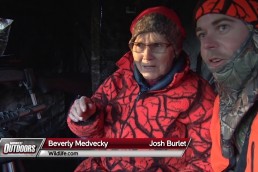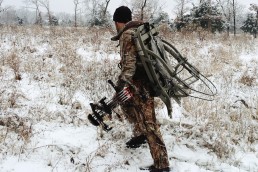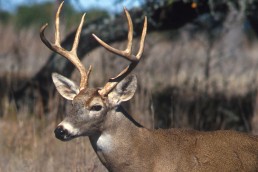Michigan’s 2018 Archery Forecast
SHARE THIS POST
Bowhunters throughout the state can expect to find favorable conditions for a successful archery season this fall.
According to the 2017 Michigan Deer Harvest Report, 311,155 bowhunters harvested 53,404 antlerless deer and 83,655 antlered bucks throughout the state, an increase of 6.6 percent and 10.9 percent, respectively, from the 2017 archery deer season.
These figures are based on surveys, which are sent to hunters via the internet or mailed, following the 2016 deer hunting seasons.
Upper Peninsula
The past two mild winters in a row should improve the amount of deer that UP hunters see while afield with archery equipment this fall. According to David Jentoft, DNR Wildlife Biologist in the Sault Ste. Marie Forest Unit, “The total accumulated snow index for the UP tracked near average for most of the winter, but jumped above average in late winter when snow storms hit in mid-to-late April. Late snow conditions are not helpful to wintering deer, and no doubt impacted some deer by keeping them in the wintering areas longer. Based on field observations this spring, it appears that the late-winter conditions may have caused fawn survival through the winter and fawn production this spring to be a little lower than those after the recent mild winters. However, those recent mild winters, in 2016 and 2017, have allowed the deer population to rebound following harsher consecutive winters of 2013 to 2015. Deer observations seem to be good in many places and hunters in the region can still expect a good deer season this fall.”
Last archery season, UP hunters harvested 1,052 antlerless deer and 6,255 antlered bucks, according to the 2018 wildlife survey.
Jentoft states, “Some staff have seen some bucks with good antler development. We anticipate having a few more mature (two and a half and three and a half year-old) bucks this year than last, due to past mild winters.”
Despite a lack of rain throughout some regions of the UP the DNR reports that soft mast crops have appeared to improve this year.
Numerous wildlife habitat projects have been completed throughout the UP. Some of these include: the planting of 350 sapling-size oak trees on 43 acres of state managed land in northern Marquette County, 1,500 in the Shingleton Forest Area to help offset the effects of beech bark disease, 400 were planted in a break-out area throughout the Newberry Management Unit, and 100 were planted on approximately 21 acres of state forest land on Drummond Island in the Sault Ste. Marie Forest Unit.
Jentoft also mentioned that 61 acres of openings were farmed in the Shingleton Forest Unit to enhance spring break-out areas.
Northern Lower Peninsula
Despite a longer than normal winter, which extended into the spring, bowhunters should still see an improvement in deer sightings this fall.
Ashley Autenrieth, DNR Deer Program Biologist in Gaylord for the UP and NLP states, “While the winter wasn’t very severe, it was a long winter, with snow still being on the ground well into April and even into May in some areas of the NLP. This has likely not impacted fawn numbers, but may have impacted fawn birth weights. When spring is delayed, oftentimes that means nutrition is impacted for the does. That, in turn, impacts nutrition for the fawns.
Some observational reports have been made of deer looking thin and being able to see ribs. This is normal to see when spring is delayed, since does’ bodies are working for providing for the fawns, but may not have quite enough resources available yet to be able to maintain a healthy weight. Lucklily, it’s been a very good growing season across the NLP thus far this summer. That should make up for any hardships during the delayed spring. Deer numbers will likely continue to be on a steady increase as they have been the last few years.”
Are you enjoying this post?
You can be among the first to get the latest info on where to go, what to use and how to use it!
Last year, bowhunters harvested 57,180 (both antlered and antlerless deer combined) throughout the Northern Lower Peninsula.
Mast crops, which include apples, appear healthy throughout the NLP. According to Autenrieth, “It appears to be a good year for apples, with many trees already heavy with this fall’s apple crop. Not sure on acorns, but the best bet is for people to seek out known oak trees in their area to see if they’re producing.”
Autenrieth concludes, “Many bucks have been sighted. All appear to be in good condition with great antler development already.”
Southern Lower Peninsula
Joe Robison, DNR Wildlife Division SE Region Supervisor remains optimistic about the upcoming archery season for Southeast hunters. He states, “Here in the southeast, the winter wasn’t terribly harsh and the fawn recruitment is good. We’ve observed many does with twins and even triplets, so there’s no reason to believe that the winter impacted fawn production. Plenty of browse, including food from agricultural lands and food plots, were available to deer throughout the winter. Green-up was a bit late, this year, but winter mortality was low.”
Last season, bowhunters harvested a total of 47,544 antlered deer in the southern lower peninsula.
The Wildlife Division continues to improve whitetail habitat by implementing numerous projects throughout the region. Robison states, “The southeast makes a concerted effort to plant food plots on all State Game Areas as a winter food source for deer, turkeys, and other wildlife. We have also been doing some timber harvesting in the Thumb region to create forest openings with great browse for deer. The Southeast is heavily involved in grassland management, as well, using prescribed burns and mowing to enhance grasslands. Grasslands provide bedding and feeding areas for deer in the milder temperatures of the winter.”
In the southwest region of the state, John Niewoonder, SW Field Operations Manager for the Wildlife Division states, “The winter of 2017-2018 was a fairly typical winter in Southwestern Michigan. While some limited fawn mortality was reported, cold snaps were not cold enough or long enough to have a significant impact on fawn or adult survival. Available browse continues to be an issue for wintering deer in SW Michigan. Most forests are becoming mature, due to a lack of active forest management on private lands. Deer densities are high and many forests have distinct browse lines where deer have consumed most of the available, high-value browse. In addition, where fall tillage of agricultural fields occurs, leftover food is unavailable to wildlife when they need it most. With little food available for much of the winter season, our deer populations will be vulnerable if we encounter a colder-than-normal winter with prolonged stretches of very cold weather.”
Throughout the southwest region, mast crops appear to be healthy. Niewoonder states, “Wild apples appear to be in good shape, with lots of fruit being produced. Acorn production seems to be average at this point in the season.”
The Wildlife Division continues to implement an active timber sale program, which continues to improve the quality of habitat for whitetails, along with other wildlife. These areas provide dense forests that provide plenty of food and cover. According to Niewoonder, “Each year, 600-1000 acres of mature forest are harvested on public lands in the Southwest Region. Young forests provide both dense cover and high-quality food for deer. In addition, food plots and sharecropping (farmers leaving crops unharvested on public lands) provide thousands of acres of quality food for deer and other wildlife.”
Chronic Wasting Disease is still a concern for Michigan’s deer population. The DNR Wildlife Division continues to work towards maintaining a healthy deer herd. According to the DNR, 31,000 free-ranging deer having been tested for CWD as of June 2018. A total of 57 deer have tested positive for CWD in the counties of Clinton, Ingham, Ionia, Kent, and Montcalm.
Niewoonder states, “In light of the discovery of CWD in the wild deer herd in portions of southwestern Michigan, it is important that hunters get their deer tested by submitting their deer heads to DNR staff and that we keep deer populations at reasonable levels. Getting deer tested and managing deer densities through hunting are important aspects of understanding this disease in Michigan, and reducing the spread of the disease to more deer and to additional areas.”
MWO
SHARE THIS POST
Did you enjoy this post?
You can be among the first to get the latest info on where to go, what to use and how to use it!
Darin Potter
Darin Potter’s passion for outdoor writing began at the age of 12 when he first began writing in a journal that his parents bought him on a family camping trip in Northern Michigan. His writings have appeared in several Midwest publications: Michigan-Out-of-Doors, Michigan and Ohio Outdoor News, Modern Pioneer, and MidWest Outdoors.



